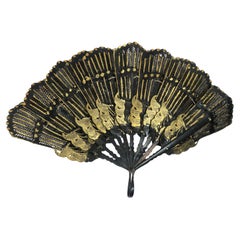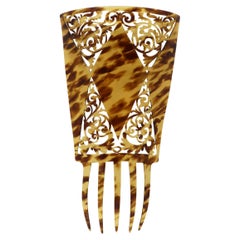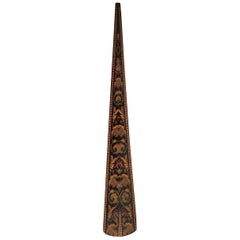Patina NYC Collectible Jewelry
to
2
2
2
1
1
1
1
1
2
2
2
19th Century Leather and Gold Leaf Hand Fan
Located in Brooklyn, NY
A stunning and rare example of a 19th century hand fan, made of black leather and decorated with gold leaf. The fan has a brisé style, meaning th...
Category
Antique Mid-19th Century Collectible Jewelry
Materials
Gold Leaf
19th Century Tortoise Shell Decorative Hair Comb or Head Piece
Located in Brooklyn, NY
A stunning and large antique 19th century tortoise shell, celluloid, or Bakelite hair comb or head piece with an intricate carved floral and open scroll ...
Category
Antique Mid-19th Century Collectible Jewelry
Materials
Plastic
Related Items
Rare 19th Century English Tunbridgeware Hair Pin or Slide
Located in Dallas, TX
PRESENTING an EXTREMELY UNIQUE and RARE 19C British Tunbridgeware Hair Pin/Bobbin or Slide.
This slide is unlike any of it’s kind we have seen before, it is a VERY RARE survivor.
From circa 1860 – 80 and made in Tunbridge Wells, England.
Made of walnut with gorgeous marquetry inlay on the entirety of the front with classic Tunbridgeware micro-mosaic all over the front. The rear is walnut.
The marquetry inlay appears to be various different woods, namely, maple, walnut and satinwood.
Would have been worn in a Lady’s hair bun with the micro-mosaic facing forward.
This would have belonged to a VERY ELEGANT LADY in the mid to late 19th Century.
Tunbridge ware is a form of decoratively inlaid woodwork, typically in the form of boxes, that is characteristic of Tonbridge and the spa town of Royal Tunbridge Wells in Kent in the 18th and 19th centuries. The decoration typically consists of a mosaic of many very small pieces of different coloured woods that form a pictorial vignette. Shaped rods and slivers of wood were first carefully glued together, then cut into many thin slices of identical pictorial veneer with a fine saw. Elaborately striped and feathered bandings for framing were pre-formed in a similar fashion.
There is a collection of Tunbridge ware in the Tunbridge Wells Museum and Art Gallery in Tunbridge Wells.
The famous makers of Tunbridge ware were in the Tunbridge Wells area of Kent; their most notable work was from circa 1830-1900.
Early makers of Tunbridge ware, in Tunbridge Wells in the mid-18th century, were the Burrows family, and Fenner and Co. In the 19th century, around 1830, James Burrows invented a technique of creating mosaics from wooden tesserae. Henry Hollamby, apprenticed to the Burrows family, set up on his own in 1842 and became an important manufacturer of Tunbridge ware, employing about 40 people.
Edmund Nye (1797–1863) and his father took over the Fenner company when William Fenner retired in 1840, after 30 years in partnership with him. Thomas Barton (1819–1903), previously apprenticed at the Wise factory, joined the Nyes in 1836, and worked as Nye’s designer; he took over the business in 1863 and continued there until his death.
In Tonbridge (near to Tunbridge Wells), George Wise (1703–1779) is known to have had a business in 1746. It continued with his son Thomas, and Thomas’s nephew George (1779–1869), who took over in 1806. In its early years the company made articles such as workboxes and tea caddies with prints of popular views; later items had pictures created from mosaics. Their workshop in Tonbridge, Wise’s Tunbridge Ware Manufactory, was next to the Big Bridge over the Medway; the building was demolished in 1886 to widen the approach to the bridge.
Tunbridge ware became popular with visitors to the spa town of Tunbridge Wells, who bought them as souvenirs and gifts. Articles included cribbage boards, paperweights, writing slopes, snuffboxes and glove boxes.
At the Great Exhibition of 1851, Tunbridge ware by Edmund Nye, Robert Russell and Henry Hollamby was shown; Edmund Nye received a commendation from the judges for his work. He exhibited a table depicting a mosaic of a ship at sea; 110,800 tesserae were used in making the picture.
The manufacturers of Tunbridge ware were cottage industries, and they were no more than nine in Tunbridge Wells and one in Tonbridge. The number declined in the 1880s; competent craftsmen were hard to find, and public tastes changed. After the death of Thomas Barton in 1903 the only surviving firm was Boyce, Brown and Kemp, which closed in 1927.
Marquetry was an old technique which was continued by Nye and Barton to create images such as birds or butterflies.
‘Green Oak’ as caused by the fungus Chlorociboria aeruginascens.
Stickware and half-square mosaic was invented by James Burrows in about 1830: a bunch of wooden sticks of different colours, each having triangular or diamond-shaped cross section, were tightly glued together; in the case of stickware, the resulting block was dried, then turned to form an article such as the base of a pincushion. For half-square mosaic, thin slices were taken from the composite block, and applied to a surface.
Tesselated mosaic, was a development by James Burrows of half-square mosaic; it was adopted by George Wise and Edmund Nye. Minute tesserae were used to form a wide variety of geometric and pictorial designs.
Many sorts of wood were used for the various colours; about 40 were in regular use. Only natural colors were used; green was provided by “green oak”, produced by the action of fungus on fallen oak. Designs for articles were often taken from designs of Berlin wool work.
Category
Antique Late 19th Century English High Victorian Collectible Jewelry
Materials
Satinwood, Walnut
Decorative Fancy Victorian Barometer, 19th Century
Located in Berlin, DE
Fancy Victorian barometer, 19th century
Mahogany veneer with inlay. Historical condition. The barometer may need to be checked for accuracy. Ple...
Category
Antique 19th Century English Victorian Scientific Instruments
19th Century Hand Forged Bear Trap
Located in Coeur d'Alene, ID
Hand forged bear trap with extra-large pan, serrated jaws attached by rivets. Unique chain attachment opposite the pan toggle. From the patina and wear this one appears to have been "a found" piece from the early 19th or 18th century.
Period: First half 19th century or 19th century
Size: 9" jaws; overall 6" x 32" x 12" H
Family Owned & Operated
Cisco’s Gallery deals in the rare, exceptional, and one-of-a-kind pieces that define the history of America and the Old West. Our pieces range from American Indian to Cowboy Western and include original items of everyday life, commerce, art, and warfare that tamed America’s frontier. Our 14,000 square foot gallery opened in 1996 in beautiful Coeur d’Alene, Idaho.
Personal Service
Cisco’s operates on old fashioned values – honesty and integrity, and all of our items are backed by our money back guarantee. We appreciate the opportunity to earn your business. Whether you desire assistance with a jewelry purchase, choosing a gift, identification, or even selling – we hope to be your trusted source.
antique hunting traps...
Category
Antique 19th Century American Sports Equipment and Memorabilia
Materials
Iron
Circular Sextant, Decorative Piece, 20th Century
Located in Madrid, ES
The sextant is an instrument that allows to measure angles between two objects such as two points of a coast or a star, traditionally the sun of the earth and the horizon. Knowing th...
Category
Late 20th Century Spanish Other Nautical Objects
Materials
Metal, Other
19th Century Mortar and Pestle
Located in Coeur d'Alene, ID
19th century fruitwood mortar and pestle. Remnants of oxblood red and silver blue banded paint. Original pestle included.
Origin: Eastern, United States
Period: First half of the 19...
Category
Antique Early 19th Century American Antiquities
Materials
Fruitwood
19th Century Pet or Doll Bed
Located in East Hampton, NY
Exquisite pet/ doll bed in the Louis XXI style. all original silk brocade drapery and upholstery. and remnants of trims. mattress is stuffed horsehair. ostrich feather floret. (the h...
Category
Antique Mid-19th Century Beds and Bed Frames
Materials
Silk
19th Century Cross
Located in Madrid, ES
19th century cross
Nice xix century cross in olive wood. Measures: 23 x 12 cm. In good condition.
Category
Antique 19th Century Italian Gothic Religious Items
Materials
Bronze
Victorian Snuff Box with Mounted Ram's Head – 19th Century
Located in Madrid, ES
An unusual and remarkable 19th-century Victorian snuff box decorated with a mounted ram's head. It is topped with a lidded silver-plated bronze container for storing snuff.
The ram'...
Category
Antique 19th Century English Victorian Taxidermy
Materials
Bronze
19th Century Top Hat and Leather Hat Box
Located in Chicago, IL
This late 19th-century English leather top hat box, paired with an American-made beaver fur top hat, exudes timeless craftsmanship and style. The b...
Category
Antique 19th Century English Edwardian Historical Memorabilia
Materials
Leather
19th Century Shield
Located in Cheshire, GB
19th Century oak Heraldic Shield With Carved Shell Work.
Dimensions
Height 18 Inches
Width 13.5 Inches
Depth 1.5 Inches.
Category
Antique Late 19th Century British Arms, Armor and Weapons
Materials
Oak
19th Century Italian Hand Carved Coral and Gold Bacchante Bacchus Cameo Pendant
Located in Haarlem, NL
19th Century Italian hand carved coral and gold Bacchante / Bacchus pendant.
Made from 9 Kt gold and natural, untreated hand carved blood coral from S...
Category
Antique Mid-19th Century Italian Collectible Jewelry
Materials
Coral, Gold
$2,800 Sale Price
20% Off
H 1.26 in W 0.87 in D 0.87 in
19th Century Brass and Gold Watch-Key
Located in Delft, NL
19th Century Brass and Gold Watch-Key
19th century brass and gold Watch-Key hanging on a small chain
The measurement is 6 cm high in total and the key is 2,5 cm wide
The weight is...
Category
Antique Early 19th Century Dutch Collectible Jewelry
Materials
Gold, Brass



